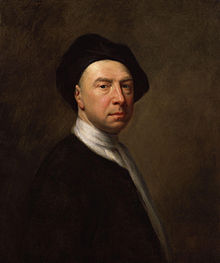Jonathan Richardson
| Jonathan Richardson | |
|---|---|

Self-portrait
|
|
| Born | 12 January 1667 London |
| Died | 28 May 1745 Bloomsbury, London |
| Nationality | British |
Jonathan Richardson (London 12 January 1667 – 28 May 1745 London) sometimes called "the Elder" to distinguish him from his son (Jonathan Richardson the Younger) was an English artist, collector of drawings, and writer on art, working almost entirely as a portrait-painter in London. He was considered by some art-critics as one of the three foremost painters of his time. He was the master of Thomas Hudson and George Knapton. Richardson was even more influential as a writer; he is credited with inspiring Joshua Reynolds to paint and theorise with his book An Essay on the Theory of Painting. This book is credited with being "the first significant work of artistic theory in English."
Richardson was born in the parish of St. Botolph, Bishopsgate in London on 12 January 1667 to William and Mary Richardson. In 1672 his father died and his mother married again. Richardson became a scrivener's apprentice, but he was released early when his master retired. Richardson was lucky enough to be taken on as a painting apprentice by John Riley. He learnt the art of portraiture from Riley whilst living at his master's house. Richardson's wife was Riley's niece.
Richardson was even more influential as a writer than as a painter according to Samuel Johnson. He is credited with inspiring Joshua Reynolds to paint and theorise with his 1715 book An Essay on the Theory of Painting. In 1722, Richardson published with his son, also Jonathan (1694–1771), An Account of Some of the Statues, Bas-Reliefs, Drawings, and Pictures in Italy (1722). The book was compiled by Richardson the elder using material gathered by his son whilst touring Italy in 1721. This was a very popular book and was used by young men as a basis for their Grand Tour. It was said that the book became the basis for future purchases of art by wealthy collectors and therefore shaped English interest in foreign old masters. It also provided an important model for Johann Joachim Winckelmann's History of Art (1764). Richardson and his son also co-authored their Explanatory Notes and Remarks on Milton's Paradise Lost (1734). These notes are, in part, a response to Richard Bentley's 1732 edition of Paradise Lost, in which he frequently faults Milton's style or places exceptionable passages in square brackets, claiming they are the work of another hand. The Richardsons' responses to Bentley helped to lay the foundation for subsequent interpretation of the poem.
...
Wikipedia
